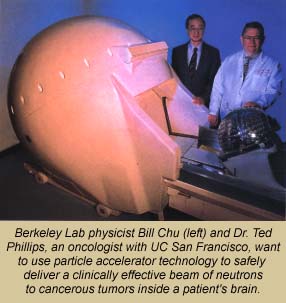
- A PRESCRIPTION FOR HOPE PART 3 -
In addition to the selectivity of the boron-carrying compound, the success of BNCT also depends upon the availability of a neutron beam with a suitable energy spectrum and sufficient intensity. The neutron beams for the early trials were produced via fission processes that take place inside nuclear reactors which were constructed at BNL and MIT specifically for BNCT tests. These reactors produced low-energy or "thermal" neutrons which did not penetrate very deeply into the brain. The results were over-irradiated skin and normal brain tissue, and under-irradiated tumors.
Much has been learned since those early trials. It is now known that boron needs to be contained within a compound that preferentially collects in tumors rather than normal cells. It is also known that the most effective neutrons for BNCT are "epithermal neutrons" (those in the one to 20,000 electron volt or 20 keV energy range) which have the penetrating power to reach deep-seated tumors.
In the past few years, researchers in Japan have reported excellent results with BNCT experiments, encouraging a revival of the research effort in the U.S and Europe. A new round of clinical trials at BNL have shown great promise. Glioblastoma multiforme tumors were destroyed, tumor regrowth was delayed, and the lives of patients were saved or extended with no adverse effect on normal brain functions. These trials are continuing, and their success is critical for demonstrating the protocols under which BNCT can achieve its maximum effectiveness.
Regardless of the ultimate success of the clinical trials at BNL, however, a major sticking point is that the neutrons being used there and elsewhere are generated in a nuclear reactor. Though modern reactors can now provide the required epithermal neutrons, the question is unavoidable: How many hospitals are willing (or legally permitted) to have a nuclear reactor on their premises?
 In proposing an alternative that
the medical community should find more palatable, Berkeley Labs Chu and
Dr. Ted Phillips, head of Radiation Oncology at the UCSF, have
organized an interdisciplinary, multi-institutional research
collaboration. Joining Berkeley Lab and UCSF as participating
institutes in this collaboration are UC Berkeley and UC Davis, Stanford
University, Loma Linda University, and the University of Washington.
In proposing an alternative that
the medical community should find more palatable, Berkeley Labs Chu and
Dr. Ted Phillips, head of Radiation Oncology at the UCSF, have
organized an interdisciplinary, multi-institutional research
collaboration. Joining Berkeley Lab and UCSF as participating
institutes in this collaboration are UC Berkeley and UC Davis, Stanford
University, Loma Linda University, and the University of Washington.
What the collaboration has proposed is a room-sized particle accelerator that would produce an intense beam of energized protons. This proton beam would in turn be used to bombard a target of lithium, producing neutrons that can be shaped into a clinically effective beam for BNCT.
Chu and his colleagues will tell you that particle accelerators are a safer, politically more realistic option for hospitals than nuclear reactors, and offer a number of technical and economic advantages as well. For example, accelerators can produce beams with more therapeutic epithermal neutrons and fewer harmful higher-energy neutrons than reactors. The cost of constructing a patient-ready accelerator-based BNCT facility should be substantially less than the cost of converting a nuclear reactor for medical use. Once up and running, operational costs for an accelerator-based facility should also be lower than those for a reactor-based system.
Then there is the by-no-means inconsequential matter of disposing of a reactor when it has reached the end of its useful life. The interior of a nuclear reactor even one designed for medical use will be highly radioactive and will need to be stored in a nuclear waste repository for several thousand years. The components of a defunct particle accelerator can be safely recycled, which in fact is what the Berkeley Lab researchers have proposed for the first prototype BNCT accelerator.
Throughout the 1970s, history was made at Berkeley Lab in particle physics and nuclear science on an accelerator called the SuperHILAC (for super-heavy ion linear accelerator). The injector in that machine the device that produced the ions that were accelerated was dubbed "Adam". In 1992, the SuperHILAC was retired and Adam was mothballed. Now, the Berkeley Lab researchers have proposed reviving Adam and upgrading it into a state-of-the-art high-current electrostatic quadrupole (ESQ) accelerator.
An ESQ consists of four electrodes arranged in a circular pattern with alternating polarities so that it can focus protons into a beam. Put two or more ESQs together and you can not only focus the protons but accelerate them as well. Using a total of 13 ESQs to accelerate protons to high energies results in a compact machine (about three meters in length) capable of delivering to a target a high-current (50 to 100 milliamps) beam of protons at 2.5 million electron volts of energy (2.5 MeV). Such a beam of protons striking a lithium target will yield a bountiful crop of neutrons.
